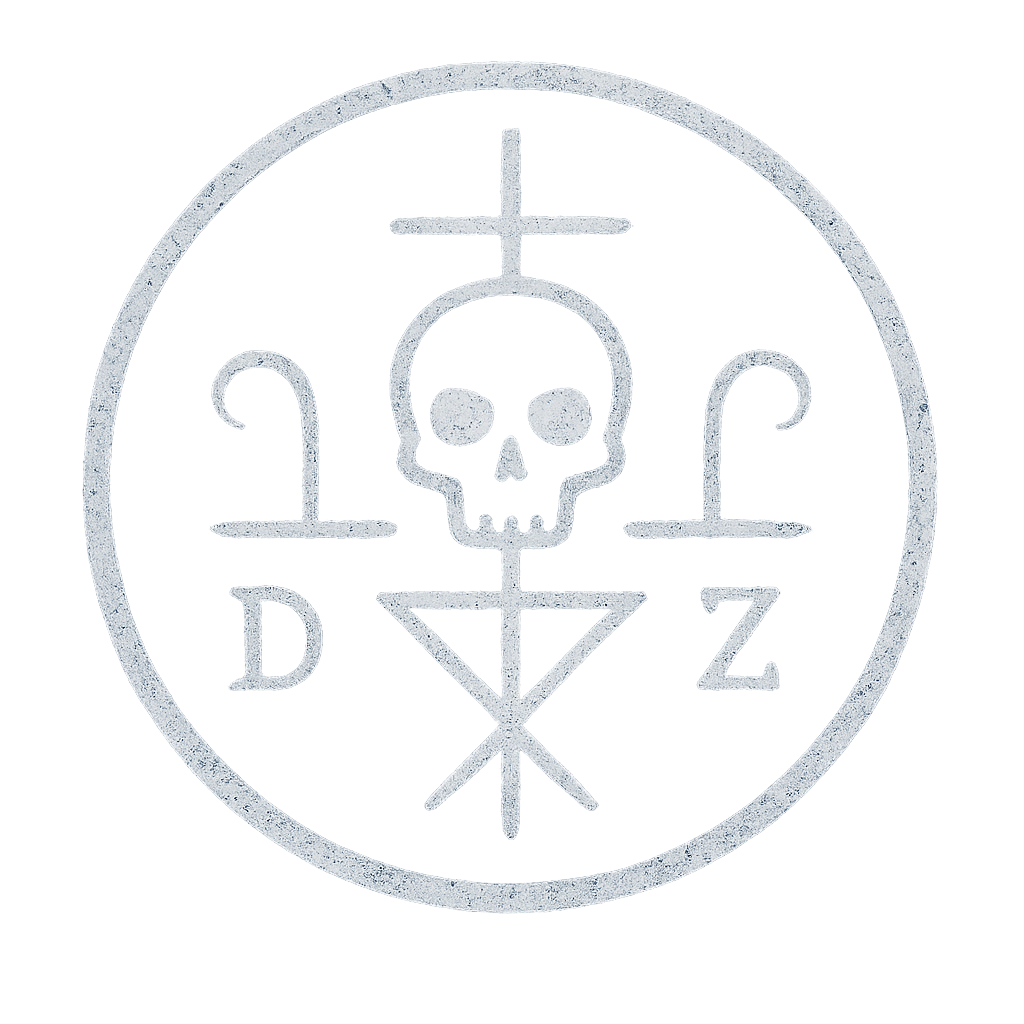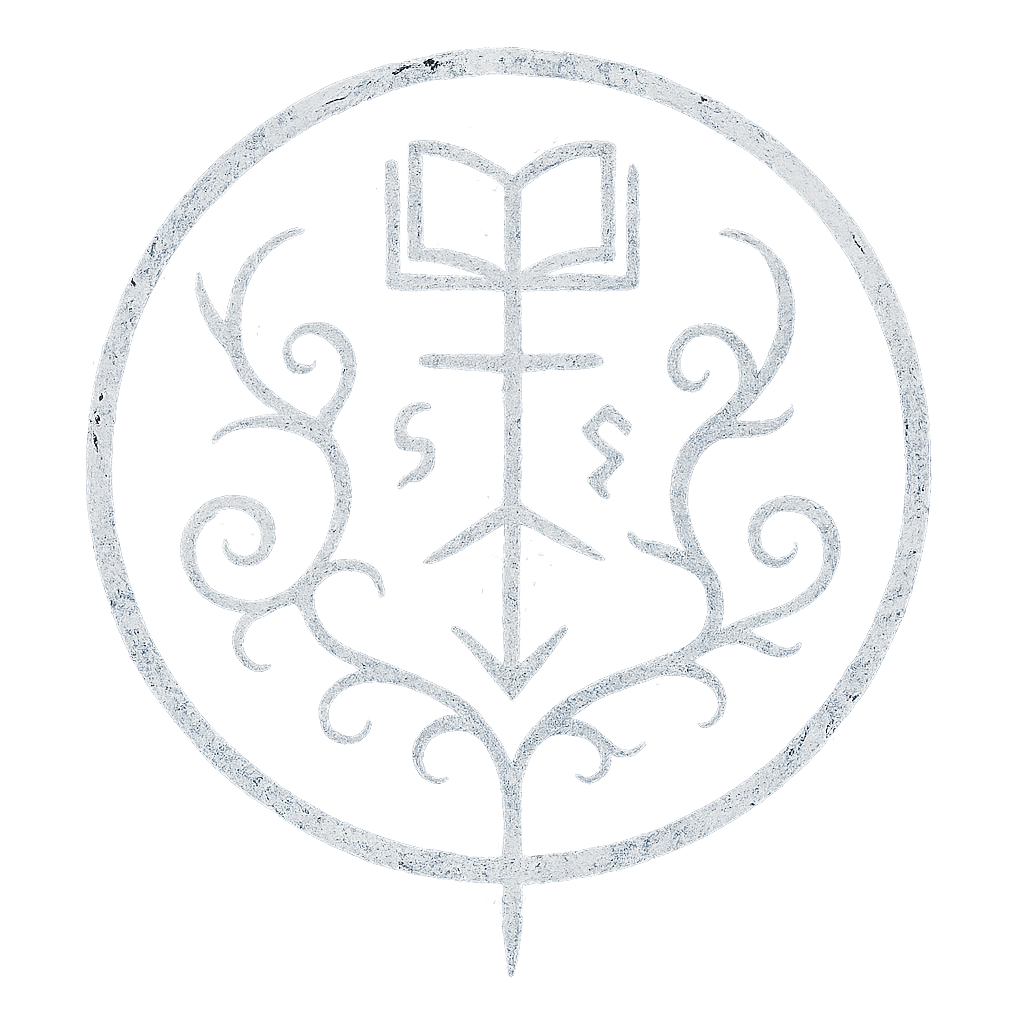The Church of Azrael
The Church teaches that decay brings renewal. Followers practice ritual mourning, bone-carving, and alchemical embalming. Priests often bear relics from those they have helped pass peacefully — and occasionally, violently.
- Tenets: Death is sacred, All can be Redeemed, Pain is Transformation
- Ranks: Acolyte, Archivist, Scribe, Missionary, Ritualist, Priest, High Undertaker, High Custodian, High Confessor
- Symbols: A Skull, its jaw bared wide in laughter
The following passages are exerpts from the Holy Book of the Church of Azrael, as spoken by Valamir Elsinahl and transcribed by Viridia:
Death Magic
Death Magic is the portfolio of Azrael, allowing users to harbor their own magic to utilize both death and disease, raising corpses. Utilizing Death Magic allows the caster to manipulate the dead and weaken the living through their own means, without affecting the target’s spiritual wellbeing.
When one raises a corpse, they are doing so by channeling their magic into their now-recycled body. Some more accomplished Death Magic users can even create a link between the spirit of the deceased and the host body to enhance this magic through a willing means.
Though many believe Death Magic to merely disrupt the organs and natural matter of a living body, the real process is much more complex. Death Magic cannot be utilized on something like a construct with no biological matter but can be utilized on an automaton who are composed of the same parts.
This is because the true nature of Death Magic is not biological at all: it is spiritual. The process of plaguing a subject, exhausting the body, or weakening one’s vigor, is simply detaching their spirit from their body. The utilization of Death Magic merely enhances or weakens that spiritual connection.
That spiritual connection is what gives Revenants their elongated lifeforce and allows Undertakers to perform ritualistic burials.
Necromancy
Necromancy is the portfolio of Necros. Through the caster’s ambition, they are led to utilize and destroy the innate magic of the spirit itself. This is more than often done not to their own, but the spirits of others. This process uses the spirit as a generator to manifest much more powerful magic. While even the most experienced Death Mage may only raise ten corpses, a fledgling Necromancer may raise up to a hundred.
Without the necessity of utilizing your own abilities, a Necromancer can achieve great feats of strength at a terrible cost. This process does not sever the soul from the body, but rather it utilizes and attacks the soul directly. This forbidden art is often found within desperate and hopeless individuals. Those that have lost much and have little in the way of power can now channel power rivaling an archfae.
The greatest weakness of a Necromancer is both their inexperience and their ambition, often leading to tactical missteps and self-destruction. Though it is possible for someone utilizing Necromancy to achieve Revenancy through Necros, many Necromancers lack the devotion and drive to follow that path, often opting for lichdom.
The process of becoming a lich is both gruelling and mysterious. The actual steps towards achieving this, I will not cite here, but the end result leaves the user with great power and elongated life, all at the cost of other living souls. Liches empower themselves through others with something known as a phylactery, allowing a lich to harness power and even steal the life of those the phylactery resides in.
The Historical Records

The Redemption of Necros
We start at the beginning, in the earliest times of man. There was no “Azrael” - only Necros. Necros was created to be the Seraph of Death, and he was tasked to deliver mortals to their permanent afterlives.
Necros felt that the Seraphim were given an unfair advantage over mortals - he felt that mortals’ lives were too fragile and too minimal, especially with all of the tenets the Seraphim represent. How can one truly attain knowledge in life to represent Raskgrim, if they have so little time? How can one establish justice on behalf of Raphael, with a lifespan that feels like mere minutes to a Seraph?
The power that Humanity held was truly miniscule compared to the power of the Seraphim, and Necros wished to make Humanity their equals. The Creator stated that only their children would attain this level of power, and that Humanity would be doomed to serve a lesser purpose for eternity according to Necros’s plan. With that, Necros rebelled.
Being labelled as an archfiend, he created what we now know as “necromancy”.
Necromancy was meant to be a mockery of the Creator’s intent. With mortal lives being so miniscule and only ever achieving longevity in the afterlife, Necros created a magic to drain the spirit of others and amplify and elongate those who wield his magic in the living realm.
In much of history, Necros is seen as a harbinger of pure evil and raw ambition. Though this may be true, there are several points where Necros showed his true nature as a Seraph. For example, his brother, Raphael, sought to die and forced Necros’s hand in helping him do so, knowing he would be the only one to oblige. It has been recorded that Necros was reluctant in doing so, and did not want to be the one to kill his brother. This is one of the biggest examples of his empathy before “redemption”.
This empathy and true nature lead him back to the Creator to receive what most Azrealeans know as “the Great Redemption”. This could not be further from the truth. What was done to Necros that day was no more redemption than severing the mind of a child for misbehaving.
The Creator ruled that Necros’s nature was inherently flawed. They removed the new powers of ‘necromancy’ he created, but with it went his ambition and jovial nature, two aspects of his personality the Creator believed contributed to his downfall.
Do we not see playful, mischievous tenets within Gelos? Do we not see ambition embodied in every Seraphim and in their followers? This left what we now know to be Azreal as a fractured soul.
He resumed his duties as Shepherd of the Dead, and was given a new tenet to oversee - known as ‘redemption’. This is the Seraph we worship today.
What once was a Seraph who ruled over power and ambition now governs mourners, confessors, and protectors of the dead. This was seen as a more suitable and appropriate role for a Child of the Creator.
Alas, as we all know, Seraphim cannot die.
What many believe to be a ‘redemption’ was simply a catalyst to a greater evil, and with the Creator’s disappearance, both the living and the Seraphim alike are left to deal with the aftermath.

Valamir Elsinahl
Once a mortal priest, now risen through undeath to shepherd the faithful. Valamir teaches that death is not an end, but a transformation — a necessary offering that grants redemption through loss. His touch is cold, his words warm, and his soul steadfast.
"We are not here to defy death. We are here to perfect it."
— Valamir Elsinahl
Valamir holds many titles. Beyond being adopted by a noble family in his youth, Valamir made a name for himself quickly within Novus long before Iphy had heard of the colony. He rose in the ranks of the Azraelean church, forging a deep friendship with the librarian Scorne and learning many secrets from him.
Despite his popularity and charisma, he is often viewed as a heretic by Azraeleans hailing from outside Novus. And who could blame them? Who else held such a kinship with their God?
He is undead, but retains his sentience. He is what is known as a "Paragon"; a chosen one of a Seraph, hand-selected to carry out their will upon the material plane. His detractors point to his unique condition as proof he is a necromancer - the highest heresy within the Azraelean Order. Despite the controversy surrounding him, he remains the High Confessor and head of the Novus Azraelean church.

Melathor
Melathor claims to be the god of Forgotten Knowledge, a being that whispers from beneath ruins and behind the eyes of the desperate. His presence is never announced, only discovered. Those who follow him often lose themselves — but gain what should not be known.
"Let them call it corruption. You call it clarity."
— Melathor (to Iphy)
Known signs: Ink bleeding from the eyes, glyphs forming unbidden, dreams filled with static and script.
